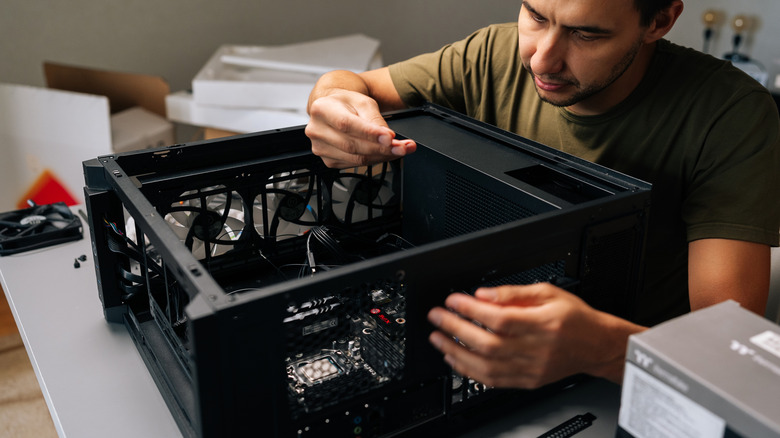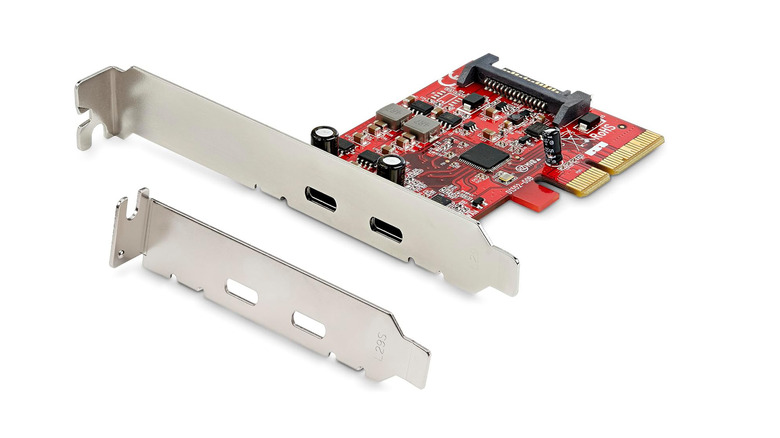Can You Upgrade Your PC's USB Ports? Here's What You Need To Know
We may receive a commission on purchases made from links.
The ubiquitous USB port has been through many iterations since it was first introduced in 1996. Developed by IBM, Intel, and Microsoft, the USB port was intended to make connecting peripherals to PCs a simpler task. Although initial adoption of the standard was slow, today, it's a standard feature on just about every digital device. Early USB ports were capable of data transfer rates of either 1.5 Mbps or 12 Mbps, while the latest USB4 2.0 protocol can support speeds of up to 80 Gbps over USB-C. In between these two extremes, there have been various iterations, and not always seeming to follow any logic — see the difference between USB 3.2 Gen 1 vs. Gen 2 for an example of this lack of logic in action.
So, with all these changes, it could be necessary to consider upgrading the USB ports on your PC. This could be to get a speed boost or just to add some more internal USB ports. What upgrading actually means will depend on your existing hardware, but there are limitations to what you can do. For instance, simply replacing the existing ports on your motherboard is neither feasible nor effective, as they will still use the existing USB controller. Instead, upgrading usually means installing a PCIe card or even replacing the motherboard. It's worth noting that plugging a faster USB hub into an existing slower port will only upgrade the number of ports and not their performance. With that said, let's have a closer look at the options for upgrading your PC's USB ports.
Why upgrading your PC's USB ports is tricky
Upgrading a PC's USB ports might sound like a fairly simple operation, but there's more to it than meets the eye. The USB controller — the component that handles the communication between your devices and the CPU — is hardwired into your motherboard's chipset. Upgrading this is impossible without replacing the entire motherboard; thus, the only practical option is to add an expansion card.
But even this may not bring the desired results. For instance, to add a USB4 PCIe Gen4 card to your PC, your motherboard will need to have a USB4 header. Installing it on boards without this will not net you the full performance, if it works at all. Then there's the matter of drivers and BIOS support to consider; not every board can recognize or utilize the latest cards. And, although it may be possible to flash the BIOS, updating your motherboard's BIOS is not without risks.
The physical design of the ports also adds a further challenge. USB-C ports require different power delivery specifications and reversible connectors that older motherboards simply weren't built to handle. For most people, this isn't a plug-and-play exercise akin to plugging a USB device into your computer. Instead, it can be a system-level operation requiring a high level of expertise. However, for those of you with the right equipment and who are comfortable with electronics and a screwdriver, installing an expansion card can upgrade your USB ports.
What you can actually do to upgrade your USB ports
One relatively straightforward option that can work in certain circumstances is to install a PCIe expansion card. But you'll first have to establish whether your PC has a free PCIe slot and also check its form factor. Some PCIe USB expansion cards, like the StarTech USB 3-2/USB-C PCIe card, have brackets for both low-profile and standard PC case sizes, but this isn't always true. So you'll always want to check that the card you're interested in fits your PC case.
As already noted, you will also need to check that your motherboard supports the card type you want to install. The easiest way to do this is to refer to the manufacturer's website. If you're unsure how to tell your board's maker and model, the information can be found in the "System Information" section of Windows. To do this, type "System Information" into the Start menu search bar and look for the listings under BaseBoard Manufacturer and BaseBoard Product. It is worth noting that PCIe is backward compatible, so most PCIe expansion cards will physically fit. However, a newer card on an older board will have its performance limited to that of the board.
If you only need more ports, not faster ones, then there are several ways you can add more USB ports to your computer. One of the easiest is a USB hub. However, unpowered hubs that draw all their power from the host port can restrict how many and what kinds of devices you can connect. Powered hubs that use an external power supply can cope with more high-draw devices with greater reliability.


